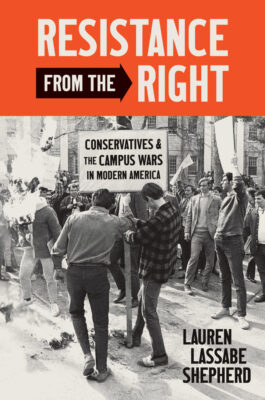Editor's Note
This is part 3 in my series on Lauren Lassabe Shepherd’s Resistance from the Right: Conservatives & the Campus Wars in Modern America. You can find parts 1-2 here and here.

This is the cover of Shepherd’s *Resistance from the Right: Conservatives & Campus Wars in Modern America*. It shows male students protesting against Students for a Democratic Society, by burning an SDS effigy, at Harvard in 1969.
The late 1960s saw campus conservatives refine techniques of emotional manipulation that would echo down through the years, even in larger contexts such as the Republican Party and in various national media endeavors. Lauren Lassabe Shepherd’s Resistance from the Right outlines two that I want to highlight today that fall in the realm of emotional manipulation: weaponized victimhood and an obsession with attractiveness.
By 1968, Shepherd tells us, organizers of the campus right felt that their work, or “branding,” would be “more effective if it promoted a shared aggrieved attitude rather than a coherent set of principles” (p. 79). Emotions, then, would center the movement against all things from, or about, The Left. They did not need to focus on small government, personal responsibility, religion, the Vietnam War, patriotism, individual freedoms, or even anti-communism. The could foster a shared sensibility through a theater, or aesthetic, focused on shared grievances. Among the varieties of grievances to share, they often utilized victimhood (ironically in relation to the long-standing conservative theme of personal responsibility).
It is clear from early in the book that victimhood is a theme. It is prominent enough to earn an index entry (p. 259), even though that entry does not capture every single instantiation of the theme in the text. Shepherd anchors her thinking in the writings of Lee Bebout, especially a pieced published in a 2020 collection, titled “Weaponizing Victimhood: Discourses of Oppression and the Maintenance of Supremacy on the Right” (p. 29, 240). Bebout’s main point is fairly obvious.
Shepherd argues that victimhood is a key organizing principle for the campus right. In Bebout’s words: “Seeing oneself as a victim is a crucial thread that weaves ideologies, identities, and historical moments together” (p. 29). Bebout pops up later in the context of a conservative activism at Columbia University in the spring of 1968. At that point in Shepherd’s history she is reflecting on the “majority coalition model” (discussed briefly in entry #2 of this series). Weaponized victimhood is, in Bebout’s theoretical model, “an excellent mobilization strategy for ‘otherwise potentially disparate groups’.” These campus conservatives can then see, or portray, themselves “as victims under siege.” They have a common feeling—an “affective state of aggrieved entitlement.” Solidarity via the “shared logic” of victimhood becomes possible (p. 89).
Another spot where this “structure of feeling” (to invoke Raymond Williams) arises is in Shepherd’s review of campus conservative’s reactions to the appearance of black studies and black educational justice initiatives. Using the example of a Cornell student’s editorial, Shepherd raises the topic of some white students feeling that their “university is disregarding white students in its dealings with the blacks” (student’s 1969 wording, p. 221n17). Shepherd again marshals Bebout to assert that white privilege is upheld “in the guise of powerlessness and justice” (p. 121-122).
Shepherd further illustrates this point with an example from the Campus Conservative Club at the University of Georgia. This group publicly touted “the ‘racial inferiority of blacks’ and ‘warned of the repression of conservative students’” (p. 123). She adds another example drawn from YAF’s New Guard magazine, wherein white conservative students described themselves as repressed in the same way as Black citizens during the Jim Crow era. They claimed that “wearing a Nixon button to class” draw the same kind of repression as having dark skin (p. 123).
Apart from race and weaponized victimhood, campus conservatives also attempted to emotionally manipulate people through the use of attractiveness. This theme did not warrant an index entry, but it still stands out for its relation to the present—especially regarding FOX News and reinforcing uniform white standards of beauty (see here for more). In Shepherd’s study, I first noticed her explicitly addressing attractiveness in the conclusion. It comes during a discussion the so-called “youth silent majority” and the need to draw attention to their points of concern (p. 186).
Shepherd defines ‘attractiveness’ as “physical desirability” but also in terms of “characteristics such as agreeableness for women and machismo for men” (p. 187). She asserts that this “pursuit of attention” via attractiveness stretched “across all clubs on the right” and “especially religious groups such as Campus Crusade for Christ” (p. 187). This meant enforcing strict gender binaries (i.e., straightness). Focusing on traditional forms of attractiveness enabled them to attack “gender nonconforming peaceniks and sissified long-haired pot smokers” (p. 186-187). This angle helped intensify their critiques of draft resistors and those soft on communism.
Straight forms of attractiveness enabled to Campus Crusaders and College Republicans, Shepherd argues, to leverage deep-pocket sources of funds. Being well-dressed, according to the standards of their elders, helped in these efforts. Dressing in a straight and square fashion allayed fears about young radical students (p. 188).
Manipulation via male and female attractiveness, then, served both outward and inward purposes. Campus conservatives looked conventional and safe for the world—like respectable people. They also appeased their donors and allayed concerns about change, resistance, and straying from purpose.
Along with humor, spoof groups, front clubs, coalition building, advisory boards, lobbying, study groups, pamphleting, and information wars, we can add emotional manipulation to the tactics employed by campus conservatives. In the larger context of the Cold War, psychological warfare tactics could potentially be used in any political endeavor. This included bending higher education to conservatives’ ideological purposes. Everything was on the table when the world was on the line.
The series continues next week. – TL

0